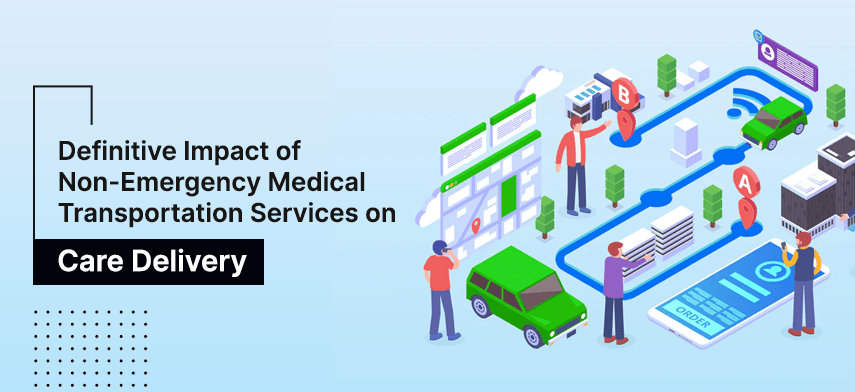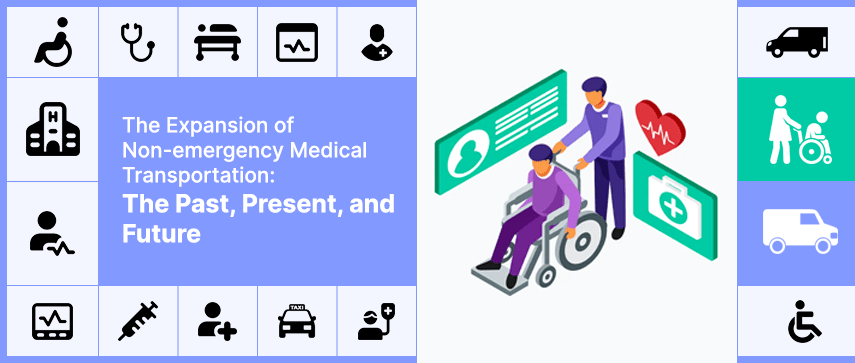Digitization and innovation have played a crucial role in mitigating safety and health risks during the COVID-19 pandemic. The efforts to reduce the impact of the pandemic have pushed the non-emergency medical transportation services industry to evolve. Hence, pushing transportation of people and delivery-based services to new heights.

The renewal of the Affordable Care Act (ACA) by the Administration of USA has expanded Medicaid services to Americans with low income. A significant investment in transportation infrastructure aims to implement the needs of people with disabilities, maintain food and medical deliveries, and constantly support autonomous and on-demand services. These are some of the most acknowledged wins ns for the NEMT industry.
Pivoting Towards Filling Service Gaps for NEMT and Healthcare Providers
The healthcare transportation services are involved in filling the service gaps that occurred due to the prevailing pandemic. While NEMT is covering the transportation gap amidst unprecedented times, patient care delivery has expanded exponentially towards technology-based Telemedicine services.
Diversification of Non-emergency Medical Transportation
The steady diversification of NEMT services has opened new doors for the industry. From facilitating prescription medicines, transportation of patients for COVID testing at healthcare facilities, to providing reduced-cost rates for rides to care home residents and to those with higher risks, NEMT has come a long way in this pandemic. Mobisoft Infotech’s NEMT platform has essentially assisted several organizations to set up transportation services during the COVID vaccination drives.
Telemedicine Platforms Ensuring Accurate Care Delivery
The growth of telemedicine has been tremendous in 2020 than in the past decade. Telemedicine’s feasibility to provide for specialty practitioners, hospitals, and senior care programs, has increased its stronghold even in the post-pandemic era. Adoption by consumers skyrocketed to 46% from 11% in 2019. Consumers are now preferring telehealth platforms for the replacement of any canceled healthcare visits. Providers are scaling their services and seeing that these offerings are increasing the number of patients who are accessing telehealth services.
Transportation Barriers Increases Inaccessibility to Healthcare
To ensure health factors and the safety of the people when traveling to healthcare appointments and doctor visits, people need access to affordable non-emergency medical transportation services. Health transportation services aren’t always as easy as it sounds, with the many obstacles that are faced frequently by people.
Let’s take a look at the transportation barriers that increases inaccessibility to healthcare.
Transportation Infrastructure
Transportation infrastructure includes limited availability of routes, overcrowding on a public conveyance, disrepair on transportation and roads, and safety concerns. These are some of the many causes for transportation barriers to accessing healthcare.
Increased Transportation Costs
With high fares, personal vehicle expenditure including insurance and maintenance, bank requirements, and vehicular access has impacted transportation barriers at exponential levels.
Vehicular Access
Lack of access to a personal vehicle or through family and friends has caused inaccessibility to receive on-time access to healthcare.
Distance and Time Constraints
Long-distance traveling paired with extreme wait time, and inconvenient time schedules have been one of the many reasons causing transportation barriers for patients and providers.
Policy Infrastructure
Budget cuts, removal of routes, shortages in a public conveyance, strikes, driver licensing barriers, and inadequate transit accessibility in underserved areas have caused an upheaval to access healthcare services to the people.
The Expansion of Non-emergency Medical Transportation: The Past, Present, and Future

The non-emergency medical transportation market was valued at $8.17 billion in 2018 and it is expected to reach $12.67 billion by 2027, exhibiting a CAGR of 4.9%. Between 2019 and 2025, the global market value for NEMT services is anticipated to grow at CAGR 7.05%.
So, how will the NEMT industry reshape itself in the next few years? Let’s have a look at the past, present, and future that shows the growth of the NEMT market in recent years.
The Past
Paving pathways to new brokers
In 2016, LogistiCare was the largest NEMT brokerage in the US when its CEO stepped down. Therefore, opening pathways for new brokers to flourish. Brokerage contracts were up for grabs in multiple states. As a result, people started dealing with completely new brokers in NEMT.
Uber, Lyft, and Other Startups
The year 2016 also marked the entry of large technology companies like Uber, Lyft, and other startups into the NEMT market. They partnered with state governments, hospitals, hospital management systems, and providers to provide NEMT dispatch solution services. Mobisoft’s NEMT software bridges the gap between healthcare providers and NEMT companies. This was a major transformation for wheelchair or ambulatory service providers in accepting new pathways for their operations.
The support from the Government
The NEMT industry wouldn’t be what it is today without billions of dollars of investment by the US government. NEMT has been controlled and regulated by state-level authorities since the mid-2010s, playing a crucial role in the growth and sustainability of the sector.
The Present
Digitized payment methods
The use of digital payment facilities, such as cards and e-wallets, warranties safer transactions. This has made care service delivery a seamless process for providers. From the users’ perspective, they can make and track payments online and better manage their finances.
Cloud computing
Health management systems were on-premise and legacy-based, previously. While the process was digital, it was restricted to a specific location or office space. Cloud computing is the new normal. NEMT employees can use mobile apps to manage and oversee all operations, including booking, pick-up and drop, payments, prescriptions, feedback, and more.
Supervision of providers
Modern-day NEMT dispatch solution systems come with real-time GPS tracking capabilities, allowing supervisors to track vehicles and drivers in real-time. Moreover, supervisors can monitor the driver and staff with the patient and replace them in case of misconduct.
Coordination and communication with Healthcare Centers
Automated calls and live chat have replaced the traditional system of phone calls and fax machines. This makes the coordination and communication process more effective, ensuring both NEMT providers and healthcare centers don’t miss any appointments, cancellations, and follow-ups.
The Future
Complete ride digitization
Cutting-edge transport dispatch software solutions with GPS and route building functionalities have resulted in higher transparency and improved quality of non-emergency medical transportation services. The complete digitization of the process will make tracking these metrics easier, allowing providers to cater to patient demands in an even better way.
Shifts in care delivery services
The increasing popularity of technology-based healthcare solutions and telehealth has led to significant shifts in care delivery. Physicians, doctors, and nurses are exiting traditional healthcare facilities to enter other care locations. Community health workers have enabled providers to deliver healthcare services and education at the patient’s location. This paves the way for possibilities like telemedicine visits, at-home care solutions, and vaccine delivery.
Assimilation of autonomous vehicles
Autonomous or “driverless” vehicles have been a topic of discussion for years, and they’re far from entering the healthcare society. However, companies like Waymo have demonstrated positive results while working on autonomous vehicles. And if all goes well, autonomous vehicles may join the NEMT workforce in about ten years.

Bottom Line,
As healthcare technology and NEMT trends continue to change, implementing a robust, flexible, and reliable NEMT dispatch software solution is crucial. Mobisoft’s NEMT dispatch solution is cloud-based that assists in streamlining NEMT services, providing a better delivery experience to consumers.
Innovation and the emergence of new technologies can reshape any industry, and NEMT is a perfect example of this. With advanced transport dispatch software solutions in the market, NEMT providers can conduct their operations in a more planned, transparent, and efficient way. For consumers, this means on-demand, on-time, and high-quality care delivery services.
Author's Bio

